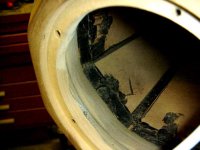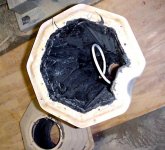One can never be 100% sure about what they're hearing, sounds like the beryllium mids and tweeters were doing their magic. You say there were metal rods clamping the woofer section, that was isolated from the mid and tweeter? In fact I'm very interested in finding some beryllium / magnesium / titanium mids and tweeters as alternatives to Accuton speakers.
I've got a 12" sub in a 60L box made of 25mm (1") marine/furniture-grade plywood, crossing over at 125Hz, and it sounds great. It does vibrate a bit, but when I do the knuckle-tap test on the box, its ringing is just high enough for me to whistle in tune to (estimating it at 450Hz). No reinforcements, just heaps of polyester wool. Now, if there was some miraculous material for tweeter enclosures with their lowest resonant frequency being above 20kHz, speaker makers would be falling over themselves trying to get their hands on it as a cone/dome material. So obviously the alternative approach has to be taken: soft and absorbant for high frequencies.
I was really interested when someone mentioned non-hardening modelling clay stuff. I think that that sort of thing could be a superb answer to mounting midranges and tweeters. What other non-hardening stuff would be good? Are there any DIY clay-like materials out there? Putty? How do we stop these things from hardening?
I've got a 12" sub in a 60L box made of 25mm (1") marine/furniture-grade plywood, crossing over at 125Hz, and it sounds great. It does vibrate a bit, but when I do the knuckle-tap test on the box, its ringing is just high enough for me to whistle in tune to (estimating it at 450Hz). No reinforcements, just heaps of polyester wool. Now, if there was some miraculous material for tweeter enclosures with their lowest resonant frequency being above 20kHz, speaker makers would be falling over themselves trying to get their hands on it as a cone/dome material. So obviously the alternative approach has to be taken: soft and absorbant for high frequencies.
My tweeters came with a thin layer of soft foam for the gasket, which is probably better. This is another argument in favour of separate enclosures: the tweeter may otherwise leak bass frequencies because of the soft mounting of the tweeter....I like the gasket idea and not screwing things in tightly. I have done something similar with blutak on my mids cabinet but nothing on the tweets as I didnt think the tweeter would cause anyting to vibrate. Hmm I guess I was wrong, now where did all that spare rubber go.....
I was really interested when someone mentioned non-hardening modelling clay stuff. I think that that sort of thing could be a superb answer to mounting midranges and tweeters. What other non-hardening stuff would be good? Are there any DIY clay-like materials out there? Putty? How do we stop these things from hardening?
coolkhoa said:amo, doing 5-inch walls is OVERKILL! ... MDF is usually the material of choice for most DIYers and commercial manufacturers, but when two relatively thin panels are combined with, say, a layer of foam, you'll achieve better results with less weight. Of course, don't expect to get away without bracing this kind of cabinet.
Overkill it is indeed, even with 18" monsters, if you use matrix bracing where the outer wall has small spans. I think the gains made from composite wall materials are relatively small. I would be concerned about differential shrinkage/movement when different materials are used. By contrast, constrained layer damping, which you alluded to, is much more effective. In fact, I would suggest that it is only surpassed by bracing in its improvement relative to the amount of material used, when achieving an inert box is the goal. I'm sure others will disagree with my opinion on this.
CeramicMan said:I was really interested when someone mentioned non-hardening modelling clay stuff. I think that that sort of thing could be a superb answer to mounting midranges and tweeters. What other non-hardening stuff would be good? Are there any DIY clay-like materials out there? Putty? How do we stop these things from hardening?
This clay is oil based, hence it does not dry out naturally. I'm told by someone who is in favour of using it, that it can be made to remain on the inside surface of enclosure walls long term without falling off, and with this method, he manages to get his boxes, which are also relatively thick and well braced, to the point where he can't feel any panel vibrations at high SPL, and it is a powerful system. The downside is the weight. You can get the clay from:
Dickblick
Some may know of this material as "plasticine." The stuff you use in art class when you are in primary school, usually it is coloured.
regards,
Paul
When overkill becomes overkill
 When does overkill become overkill?
When does overkill become overkill?
When you put in a little extra, yet you don't expect to really notice the difference, yet you gain satisfaction out of it, knowing you didn't cut corners, that isn't overkill ...
When you put veneer on the rear of your speaker which you will never really see, yet because you built it you know it's there and you feel better about it, that isn't overkill ...
I just thought of a DIY definition of overkill:
When you gain nothing
yet the price is too high
or
When you gain very little
yet this is overshadowed by problems of far greater significance
if your room with a subwoofer becomes a subwoofer with a room
if your sound system with nice cables becomes nice cables with a sound system
if your chiropractor bills exceed your budget for your speaker with 5" walls
..... or when your wife also wants to get her hands on your diy speakers
ok now I'll stop rambing
cheers,
Paul
When you put in a little extra, yet you don't expect to really notice the difference, yet you gain satisfaction out of it, knowing you didn't cut corners, that isn't overkill ...
When you put veneer on the rear of your speaker which you will never really see, yet because you built it you know it's there and you feel better about it, that isn't overkill ...
I just thought of a DIY definition of overkill:
When you gain nothing
yet the price is too high
or
When you gain very little
yet this is overshadowed by problems of far greater significance
if your room with a subwoofer becomes a subwoofer with a room
if your sound system with nice cables becomes nice cables with a sound system
if your chiropractor bills exceed your budget for your speaker with 5" walls

..... or when your wife also wants to get her hands on your diy speakers

ok now I'll stop rambing
cheers,
Paul
Variac said:I saw and listened to the TAD speaker at the audio show here in S.F. It was built out of stacked layers as described. There were metal rods vertically clamping it -presumably it's glued also
All thread would wwork well for this.
It's a method of making cabinets I've considered a lot. $600 for materials and cutting might be a pretty good deal. 5" walls are going to be a problem because the may block sound from the back of the woofer a bit. The walls of the TAD were about 2.5" to 3" I think. Some of the layers had Y shaped bracing between the walls. From my inspection there were say 3 layers with braces, the a bunch without, then more braces.
After seeing and hearing the speaker, I'd say GO FOR IT!! but walls like TAD uses are probably enough. The only problem with thicker walls are that the speaks will be HUGE and material cost.
The TAD "head" with the combo 3" mid and 1" dome (both Berillium) is mounted on firm but flexible material to decouple it from the bass box exactly as mentioned above by 5th Element.
The speakers were some of the more impressive I heard- especially for large scale stuff like symphonic music
Thank you for the inspiration! Their design was ported, was it not?
I go along with mwmkravchenko's idea, I have done a DIY using a similar technique with very satisfying results. Two layers of 3/4 MDF with a Tar Slurry in-between (roof patch tar from Home Depot), the inside staves were only affixed with the tar, so their are not rigidly coupled to the outer enclosure, then another layer of Tar on the inside. That only takes care of part of the problem though; IMO the Midrange is the area where this is most important for clean micro-dynamics. A egg shape is the best, but a tapered design IMO works just as well.
Attachments
kingdaddy said:I go along with mwmkravchenko's idea, I have done a DIY using a similar technique with very satisfying results. Two layers of 3/4 MDF with a Tar Slurry in-between (roof patch tar from Home Depot), the inside staves were only affixed with the tar, so their are not rigidly coupled to the outer enclosure, then another layer of Tar on the inside. That only takes care of part of the problem though; IMO the Midrange is the area where this is most important for clean micro-dynamics. A egg shape is the best, but a tapered design IMO works just as well.
I have a couple of questions:
1. Why did you choose tar?
2. What is best about an egg shape?
I'm intrigued about your comments on midrange and micro-dynamics. What strategy do you suggest to get the best midrange. Would you consider totally absorbing the rear wave within the enclosure to be the best approach?
It seems to me that if midrange accuracy is the goal, then the backwave should be absorbed within the box, so the box should be rigid and a lot of stuffing used, so that the rear wave is all absorbed and the minimum is transmitted through the walls and cone.
regards,
Paul
1. Why did you choose tar?
Because it has an irreguler shape when cured and it's very dense, it also penetrates into the wood (oil based) changing the overall resonance of the MDF.
2. What is best about an egg shape?
An Ovoid is the perfect geometric shape for standing waves, no parallel surfaces. However a sphere can do as well as long as there isn't significant pressure form the driver. If you put a ball of poly-fill in a net and suspend it in the middle of a sphere it will do a close version to a Egg shape interior. The Egg shape exterior is also a near perfect acoustical shape for diffraction, so overall IMO the egg shape is the best for midrange.
In-addition Yes, I do believe that totally reducing the back-wave pressure will increase Micro-Dynamics, I like tapered polygons, spherical, cylindrical, and nautilus shaped enclosures for all but the very low’s. Anything but a BOX!
- Status
- This old topic is closed. If you want to reopen this topic, contact a moderator using the "Report Post" button.
- Home
- Loudspeakers
- Multi-Way
- 5 inch walls?

